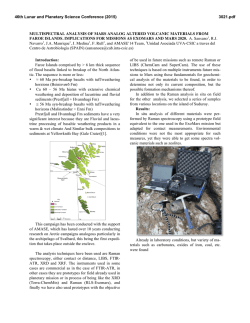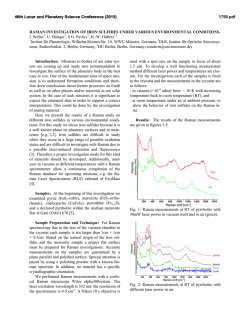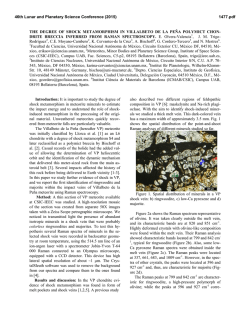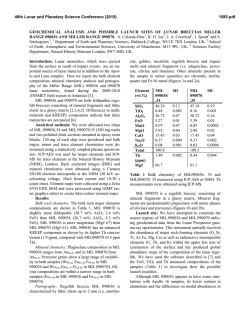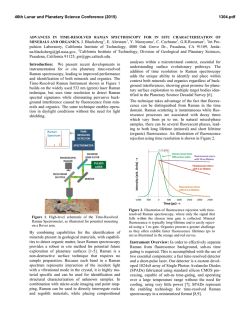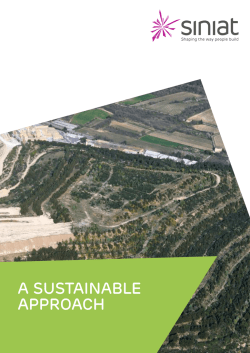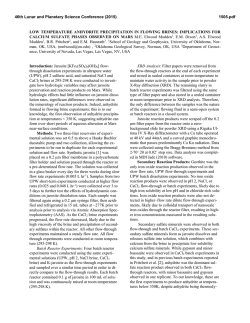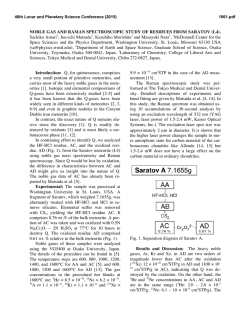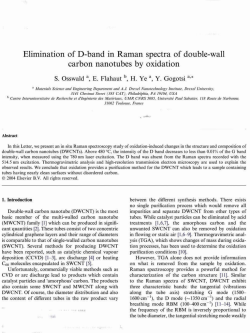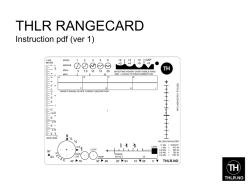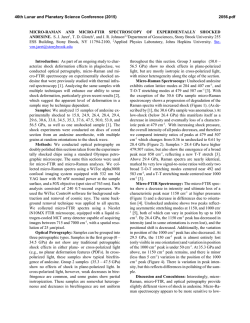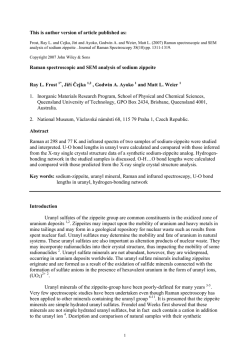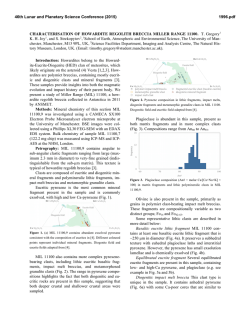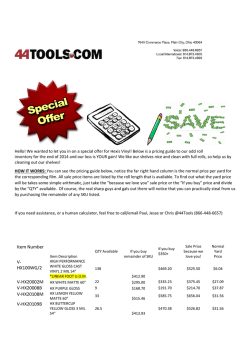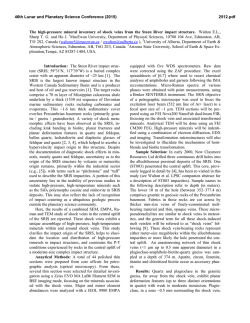
ABUNDANT BASSANITE AND r
46th Lunar and Planetary Science Conference (2015) 2598.pdf ABUNDANT BASSANITE AND γ-CASO4 IN MIL 03346,168 METEORITE Zongcheng Ling1, Alian Wang2 1 Shandong Provincial Key Laboratory of Optical Astronomy and Solar-Terrestrial Environment, Institute of Space Sciences, Shandong University, Weihai, 264209, P. R. China; 2Dept Earth & Planetary Sciences and McDonnell Center for the Space Sciences, Washington University in St. Louis, ([email protected]). MIL03346 meteorite: It is a martian 1008, 1015, 1017, and 1025 meteorite (nakhlite) collected from Miller cm-1 respectively, which can be distinguished even at low Range, Antarctica. It contains variety of spectral resolution of the paylhydrous Ca- and Fe3+-sulfates, and other oads. Ca-sulfates were found in H2O/OH-bearing species, thus has been extensively studied, with a purpose to MIL 03346 [5-7], including a build the links to aqueous alteration study using Raman line scans that identified the presence of processes on Mars [4-9]. The martian origypsum and bassanite [9]. We gin of Ca-sulfates and jarosites in MIL found that Ca-sulfates in MIL 03346 is validated by the finding of these 03346, 168 occur only as vein sulfates on Mars through orbital remote filling phase (as shown in Fig. sensing and surface explorations by rovers [e.g., 1-3], although there are doubts on 1.). Three hydration degrees of Ca-sulfate exist in this metethe potential terrestrial contaminations orite, i.e., gypsum, bassanite [4-7]. We conducted a detailed Raman specand γ-CaSO4, no anhydrite troscopy and Raman imaging investigation (β-CaSO4) was identified. on a MIL 03346,168 thin section, with the Fig. 1a shows a vein filled with goals (1) to characterize the molecular Ca-sulfates in region C of MIL forms (including hydration degrees) of 03346,168, evidenced by a Fig.1. Typical appearance of alteration species, (2) to find the spatial gradual change from a single Ca-sulfates in MIL 03346, 168 correlations among them, (3) as well as their spatial distribution. Here, we report the abundant existence of bassanite in this meteorite, which agrees with the finding by CheMin on Curiosity rover at Gale Crater in Sheepbed mudstone samples. Sample and Measurements: A thin section, MIL 03346,168, was investigated using a new Raman imaging facility, a multi-wavelength inVia® Raman System (Renishaw Company), at Washington University in St. Louis. The green laser line (532 nm by Nd:YAG laser) is focused on the sample using 50xL or 100xL objectives, leading to an approximately 1 µm diameter spot. This Raman spectrometer has a spectral resolution about 1 cm-1. Its wavelength calibration and the laser wavelength calibration support a Raman peak position accuracy and precision of ± 0.2 cm-1. The typical Raman spectra for individual minerals grains were generally collected between 75 to 1350 cm-1 with a exposure time of 30 s for 2 co-add. In this configuration, there was no fluorescence interference for obtaining high quality Raman spectra from this meteorite sample, except when Fig.2. Characteristic Raman spectra of Ca-sulfates hitting the epoxy filled cracks in thin section. found in MIL 03346, 168 Ca-sulfates and their abundances in MIL 03346: Ca-sulfates with different hydration degrees each have a Raman peak at 1008 cm-1 (Pos 1 of Fig. 2a, gypsum finger-print Raman spectral pattern that makes their mainly), to double peak (Pos 2 & 3, mixtures of gypsum distinction very straightforward. For example, the cha- and bassanite), and finally a single peak at 1015 racteristic sharp and strong ν1 peak for gypsum (Ca- cm-1(Pos 4, bassanite mainly). The water peaks in 3300SO4.2H2O), bassanite (CaSO4.1/2H2O), anhydrite 3600 cm-1 (Fig. 2b) are also distinguishable [10]. Figure (β-CaSO4) and soluble anhydrite (γ-CaSO4) occur at 1b shows a vein mostly filled with bassanite, but contain a grain of γ-CaSO4, whose spectrum in Fig. 2b indicates 46th Lunar and Planetary Science Conference (2015) no H2O in its structure. Fig. 3. The spatial distribution of Ca-sulfates in MIL 03346, 168 The spatial distributions of three Ca-sulfates in MIL 03346,168 are plotted in Figure 3. We have found that bassanite is the most abundant Ca-sulfate (290 measurements), and has the widest spatial distribution in the vein system of this meteorite. γ-CaSO4 is the second most abundant Ca-sulfate (55 measurements), and presents as single phase or co-exist with basanite or jarosite in region E and C mostly. Gypsum has the lowest abundance (22 measurements), and presents in the veins occurring along the edge in region C and B (with one exception). Formation paths of Ca-sulaftes: It has been commonly known that gypsum is the most stable phase at low temperature (T) < 97°C; anhydrite is stable at T > 97°C; bassanite is metastable at all temperatures; and γ-CaSO4 is normally unstable [11]. The abundant bassanite and its wide-spreading in this meteorite and the persistence of γ-CaSO4 are extraordinary, but not totally against the in situ and orbital observations from Mars [3,12], and the in situ observation from hyperarid region on Earth [11]. On the basis of past experimental studies, we could hypothesize three possible formation paths for the abundant and wide-spreading bassanite in the vein system of this meteorite. Path-A is by dehydration of gypsum, which is unlikely to occur on Mars based on the evaluation of gypsum dehydration rate under Mars relevant conditions made by Robertson and Bish (2013, [13]). Path-B is by direct precipitation of bassanite from a Ca-S-H2O brine in an environment with extremely low water activity. This condition could be satisfied on Mars by: (1) extremely low atmospheric partial water pressure (PH2O), (2) extremely high ionic strength in the 2598.pdf original brine. The case for (1) would stand if the bassanite precipitation from only a few drops of brine, i.e., the precipitation was heavily affected by surrounding atmosphere, which is against the abundant bassanite with wide spreading in this meteorite. The case for (2) would stand for some veins where bassanite was found co-existing with jarosites (and/or ferrihydrite). Note this multi-phase vein was less frequently observed, most veins filled with Ca-sulfates are without co-existing jarosites, etc. Path-C bears certain relationship with the path-B, without requiring high ionic strength in the original brine. Two recent experimental studies [14, 15] on the gypsum precipitation from unsaturated brine have found that the procedure went through three steps. It was found that microscopic nano-rods of bassanite always precipitated first as a precursor. The nano-rods (10-100 nm in length) of bassanite then self-assembled into aggregates of sub-µm in diameter and > µm in length but retained a bassanite structure. Only up to the third step, structural transformation to gypsum would happen. We hypothesize that within an extremely confined space in veins of MIL 03346 and with high solid/fluid ratio, the three steps gypsum formation may have not reached the full completion. It may have stopped between step two and three, and appeared in the Raman spectra of many vein filling materials as a major peak of bassanite at 1015 cm-1 and a gypsum peak-shoulder at 1008 cm-1. Currently, we can make a tentative assignment on the formation mechanism of bassanite in most veins of MIL 03346,168 by Path-C. For both path B and C, the solubility of CaSO4 in H2O, 0.205 g/100 g H2O at 25 °C [16] requires the volume of original brine to be 1350 times of that of a vein in order to fill it with bassanite (density =2.69-2.76 g/cm3). Based on that, we support the Martian origin of Ca-sulfates in vein system of this meteorite. The possibility of some bassanite rehydrating fully to gypsum near the surface of this meteorite, induced by Antarctica melting ice, would remain. In addition, experimental study on stability of γ-CaSO4 is ongoing. Acknowledgements: This work was supported partially by the National Natural Science Foundation of China (41473065,41373068, U1231103) for ZCL, and partially by Washington University in St. Louis for AW. References: [1] Bibring J. P. et al. (2006) Science 312, 400-404. [2] Squyres et al. (2012) Science, 336,570-576. [3] Vaniman, et al. (2014) Science, 124348. [4] Changela H. G. et al. ( 2011) Meteoritics & Planet. Sci. 45, 1847-1867. [5] Hallis L. J. et al. (2011) Meteoritics & Planet. Sci. 46,1787-1803. [6] Hallis L. J. et al. (2012) GCA, 97,105-119. [7] Hallis L. J. et al. (2014) GCA, 134, 275-288. [8] Day et al. (2006) Meteoritics & Planet. Sci. 41,581-606. [9] Kuebler K. E. (2013) JGR, 118(3), 347-368.[10] Chio C. H. et al. (2004) Am. Miner., 89(2-3), 390-395. [11] Wei J. et al. (2014) 11th GeoRaman, 5012. [12] Wray J.J. et al. (2010) Icarus, 209(2), 416-421. [13] Robertson K. and Bish D. (2013) Icarus, 223(1), 407-417. [14] Van Driessche A. E. S. et al. (2012) Science, 336, 69-72. [15] Wang Y. W. et al. (2012) Chem. Comm.,48(4), 504-506. [16] Lide D.R. (2001) CRC Press, London.
© Copyright 2026

